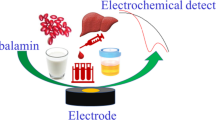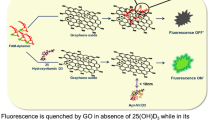Abstract
Biosensors are the state-of-the-art devices which enact in a perfect synchronization with biorecognition material, target analyte, and a close contact transducer for the detection of biomolecules. Electrochemical enzyme-based biosensors are one of the most successful group of sensors where nanomaterials are integrated to increase sensitivity, stability, response rate, limit of detection, and other analytical parameters. This has led to the development of precise and sensitive analytical device, using biological sensing element as biosensor. Not only that, it’s imperative utilization in the field of drug discovery, biomedicine, food safety standards, defense, security, and environmental monitoring, the electrochemical sensor has gained paramount importance. The present study provides a highlight on a point of care system for measuring vitamin D3, the biomarker for cardiovascular disease, obesity, and diabetes, from serum samples, comprising a three-electrode system biosensor. An enzyme responsive to the select biomarker is immobilized on the working electrode surface, enabling a change in current flow between the working electrode and the auxiliary electrode. This change helps the device, in detecting the physiological range of the said biomarker, present in the medium. The process for the estimation of 25-Hydroxyvitamin D3 in a serum sample involves; the use of anti-VD3 1 A hydroxylase enzyme antibody, for estimation of the sample analyte, vitamin D3. The electrode system is coated with a redox mediator along with a linker molecule, to immobilize the anti-Vit D3 antibody on the electrode surface. Advantageously, the said system provides a cost-effective and high fidelity point of care detection device, finding it’s application in health care.
Access this chapter
Tax calculation will be finalised at checkout
Purchases are for personal use only
Similar content being viewed by others
References
Vigneshvar, S., Sudhakumari, C.C., Senthilkumaran, B., Prakash, H.: Recent advances in biosensor technology for potential applications—an overview. Front. Bioeng. Biotechnol. 4 (2016)
Grieshaber, D., MacKenzie, R., Vörös, J., Reimhult, E.: Electrochemical biosensors—sensor principles and architectures. Sensors 8, 1400–1458 (2008)
Clark, L.C., Lyons, C.: Electrode systems for continuous monitoring in cardiovascular surgery. Ann. N.Y. Acad. Sci. 102, 29–45 (1962)
Pohanka, M., Skládal, P.: Electrochemical biosensors-principles and applications. J. Appl. Biomed. 6, 57–64 (2008)
D’Orazio, P.: Biosensors in clinical chemistry. Clin. Chim. Acta 334, 41–69 (2003)
Kucherenko, I.S., Soldatkin, O.O., Kucherenko, D.Y., Soldatkina, O.V., Dzyadevych, S.V.: Advances in nanomaterial application in enzyme-based electrochemical biosensors: a review. Nanoscale Adv. 1, 4560–4577 (2019)
Wang, J.: Real-time electrochemical monitoring: toward green analytical chemistry. Acc. Chem. Res. 35, 811–816 (2002)
Švorc, J., Miertuš, S., Katrlík, J., Stred’anský, M.: Composite transducers for amperometric biosensors. The glucose sensor. Anal. Chem. 69, 2086–2090 (1997)
Zhu, Z., Garcia-Gancedo, L., Flewitt, A.J., Xie, H., Moussy, F., Milne, W.I.: A critical review of glucose biosensors based on carbon nanomaterials: carbon nanotubes and graphene. Sensors 12, 5996–6022 (2012)
Peña-Bahamonde, J., Nguyen, H.N., Fanourakis, S.K., Rodrigues, D.F.: Recent advances in graphene-based biosensor technology with applications in life sciences J. Nanobiotechnol. 16, 75 (2018)
Pingarròn, J.M., Yáñez-Sedeño, P., González-Cortés, A.: Gold nanoparticle-based electrochemical biosensors. Electrochim. Acta 53, 5848–5866 (2008)
O’Neill, R.D., Chang, S.C., Lowry, J.P., McNeil, C.J.: Comparisons of platinum, gold, palladium and glassy carbon as electrode materials in the design of biosensors for glutamate. Biosens. Bioelectron. 19, 1521–1528 (2004)
Zhou, W., Huang, P.J., Ding, J., Liu, J.: Aptamer-based biosensors for biomedical diagnostics. The Analyst 139, 2627–2640 (2014)
Belluzo, M.S., Ribone, M.E., Lagier, C.M.: Assembling amperometric biosensors for clinical diagnostics. Sensors 8, 1366–1399 (2008)
Nair, R., Maseeh, A.: Vitamin D: the “sunshine” vitamin. J. Pharmacol. Pharmacother. 3(2), 118–126 (2012)
Institute of Medicine, Food and Nutrition Board: Dietary Reference Intakes for Calcium and Vitamin D. National Academy Press, Washington, DC (2010)
Jones, G.: Pharmacokinetics of vitamin D toxicity. Am. J. Clin. Nutr. 88, 582S-S586 (2008)
Ma, S.-X., Mayer, E., Lee, P., Li, X., Gao, E.Z.: Transcutaneous electrical stimulation increased nitric oxide-cyclic GMP release biocaptured over skin surface of pericardium meridian and acupuncture points in humans. Acupunct. Electrother. Res. 40(2), 73–86 (2015)
Author information
Authors and Affiliations
Corresponding author
Editor information
Editors and Affiliations
Rights and permissions
Copyright information
© 2021 The Author(s), under exclusive license to Springer Nature Singapore Pte Ltd.
About this chapter
Cite this chapter
Ghosh, M., Koley, C. (2021). An IoT Enabled Enzyme Embossed Biosensor for Determination of Vitamin D Level in Human Blood Sample. In: Dutta, G., Biswas, A., Chakrabarti, A. (eds) Modern Techniques in Biosensors. Studies in Systems, Decision and Control, vol 327. Springer, Singapore. https://doi.org/10.1007/978-981-15-9612-4_4
Download citation
DOI: https://doi.org/10.1007/978-981-15-9612-4_4
Published:
Publisher Name: Springer, Singapore
Print ISBN: 978-981-15-9611-7
Online ISBN: 978-981-15-9612-4
eBook Packages: EngineeringEngineering (R0)




